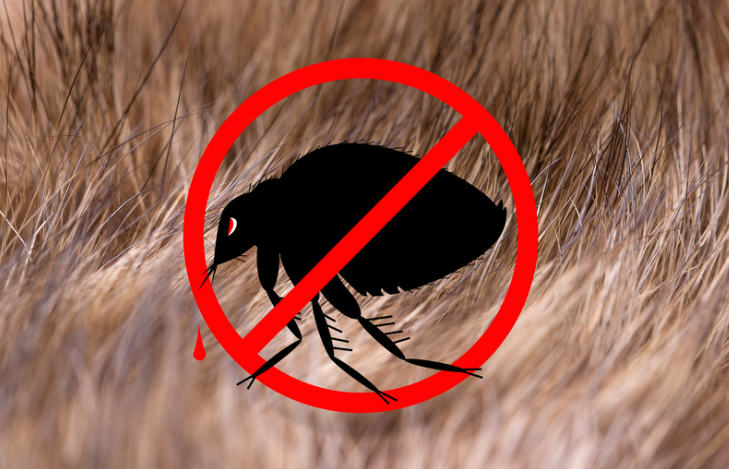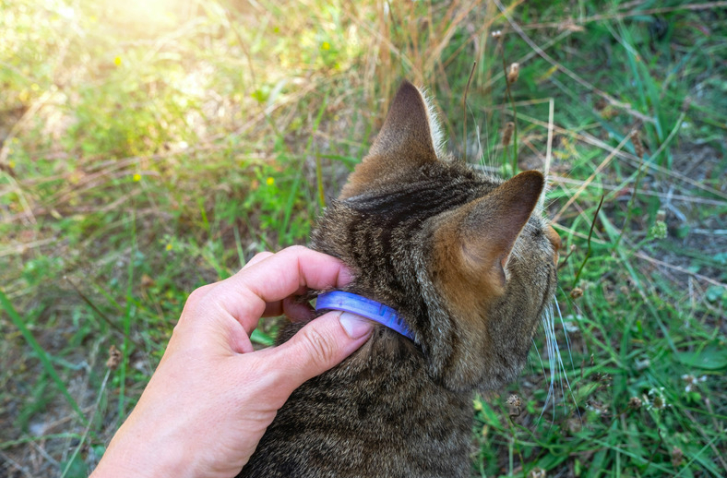Unraveling How They Keep Your Pets Flea-Free
Welcome to our comprehensive guide on the frontline defense against fleas: the flea collar. When our furry friends suffer the incessant itching and discomfort caused by these tiny pests, it’s not just a pet issue; it’s a household concern. Flea collars, often underestimated, play a pivotal role in our arsenal against fleas. By understanding their functionality and proper use, we empower ourselves to protect our pets more effectively.
Fleas are more than just a nuisance; they are adept at making your pet’s life miserable. These diminutive parasites thrive by consuming the blood of their hosts. Which often leads to a host of problems, including flea allergy dermatitis, tapeworms, and in severe cases, anemia. This is where the flea collar comes in—a seemingly simple yet sophisticated device designed to ward off these pests.

Flea collars don’t just repel; they are engineered to release active ingredients over time, providing continuous, long-term protection. However, they are not a one-size-fits-all solution. Their effectiveness hinges on the selection of the right type based on your pet’s specific needs and circumstances. From traditional options laden with insecticides to natural and ultrasonic alternatives. Flea collars have evolved to meet diverse preferences and safety concerns.
Flea Collars … The Details
Every flea collar contains a combination of carefully measured active ingredients, typically released at a steady rate. This meticulous design envelops your pet in a protective barrier against fleas. Understanding the inner workings of these collars is crucial for any pet owner aiming to make an informed decision. We delve into this topic not just with the intent to inform but to equip you with the knowledge to choose the best protection for your four-legged family members.
As the lead writer for “Flea Bites,” our commitment goes beyond providing insights. We prioritize your pet’s health and your peace of mind, recognizing the critical role they play in your life. Let’s unravel the mystery of flea collars together, ensuring you’re equipped to keep your pets happy, healthy, and flea-free.
This introduction lays the groundwork for the detailed exploration that follows, designed to guide you through the intricate world of flea collars. We’ve gathered the most accurate and up-to-date information. Supported by authoritative sources such as the Environmental Protection Agency. Which offers a wealth of knowledge on pesticides and pet products. Ensuring that every recommendation we make is backed by science and trusted expertise.
Stay with us as we delve into the science behind flea collars, discuss the various types available on the market, and help you select the right one for your pet. With our guidance, you’ll be well on your way to resolving your flea conundrums.
The Science Behind Flea Collars
Venturing into the realm of flea collars necessitates a deep dive into the very science that makes them an effective tool in combating flea infestations. The core of their efficacy lies in the active ingredients. Which are meticulously selected for their ability to fend off fleas. These ingredients fall into two main categories: insecticides, which eradicate adult fleas, and insect growth regulators (IGRs), which prevent the maturation of their offspring, breaking the life cycle.

Active Ingredients Used in Flea Collars
Insecticides are the frontline warriors in flea collars. Commonly used insecticides include pyrethrins, natural compounds derived from chrysanthemum flowers, and imidacloprid, a synthetic insecticide. Pyrethrins attack the nervous systems of fleas. Leading to their quick demise, while imidacloprid offers a more targeted approach. Specifically attacking the nerve receptors of these pests without harming your pet. These compounds not only kill fleas on contact but also provide a deterrent to keep them away.
Insect Growth Regulators: Methoprene and Pyriproxyfen
Equally vital are the IGRs like methoprene and pyriproxyfen. These chemicals mimic juvenile growth hormones in fleas. Disrupting their life cycle and preventing larvae from developing into breeding, biting adults. This dual attack—killing adults and halting reproduction—ensures a comprehensive strategy in flea control, keeping future generations at bay.
How Flea Collars Are Engineered to Release Chemicals Safely
A flea collar’s design is not a matter of happenstance. It embodies a precise science where the slow release of these potent ingredients is calculated to maximize efficacy and minimize risk.
Time-Release Technology Explained
Modern flea collars use time-release technology, which is essentially a controlled diffusion of active ingredients embedded in the collar’s material. This gradual release ensures a consistent dosage is maintained over the collar’s active life. Providing long-lasting protection without the need for frequent reapplication.
The Skin and Fur Factor: Distribution of Active Ingredients
Understanding how these chemicals spread over your pet’s body is crucial. The active ingredients are designed to capitalize on the natural oils of your pet’s skin and fur. These oils help disperse the compounds across the body, ensuring an even distribution for comprehensive coverage.
The integration of these scientific principles into the manufacturing of flea collars results in a product that is not just effective but also safe when used as directed. By leveraging the latest advancements in veterinary science and pet care technology. Flea collars have become a sophisticated means of controlling flea populations on our pets.
To further substantiate the details on active ingredients, one can refer to resources such as the National Pesticide Information Center (NPIC). Which provides peer-reviewed information about pesticide-related subjects, adding an extra layer of credibility to the information presented.
In the following sections, we’ll explore the practical aspects of these scientific principles. Guiding you through the selection and use of the most suitable flea collar for your beloved pet.
Types of Flea Collars
Selecting the ideal flea collar for your pet involves sifting through a myriad of options. Each with its own set of advantages and considerations. It is crucial to understand the distinctions between chemical, natural, and ultrasonic flea collars to make an educated choice that aligns with your pet’s health needs and your personal preferences.
Chemical Flea Collars: A Potent Shield
Chemical flea collars are imbued with active insecticidal ingredients. Which have been the traditional choice for their potent and fast-acting protection. These collars typically offer a high level of efficacy against fleas, with the added benefit of killing or repelling ticks and other parasites. However, pet owners must weigh this against potential sensitivities. As some pets may react to the strong chemicals used in these collars. It’s a balance of immediate effectiveness against the backdrop of individual tolerance.
Pros and Cons: Efficacy vs. Sensitivity
The decision to opt for a chemical flea collar should be measured against your pet’s specific condition, such as skin sensitivity, age, and overall health. While the protection offered is substantial, the pros and cons must be evaluated. Pet owners should also consider the environment in which their pet spends time. For instance, pets that are frequently outdoors may require the robust defense that chemical collars provide.
Natural Flea Collars: Organic Alternatives
For those seeking a gentler approach, natural flea collars present a viable alternative. These collars typically use essential oils and herbal ingredients, such as citronella, eucalyptus, or neem, to repel fleas naturally. While they are a more environmentally friendly option and generally safer for pets with sensitivities. Their efficacy might not match that of their chemical counterparts and may require more frequent replacement to maintain their flea-repelling properties.

Herbal Ingredients and Their Flea-Repelling Properties
The appeal of natural flea collars lies in their incorporation of herbal ingredients that serve as natural pest deterrents. It is essential for pet owners to research and confirm that the essential oils used are safe for their pets. As some can be harmful if not properly diluted or if applied in excessive amounts.
Ultrasonic Flea Collars: The Sound Solution
Advancements in pet care have introduced ultrasonic flea collars. Which repel fleas by emitting high-frequency sound waves that are intolerable to pests but inaudible and harmless to pets and humans. The effectiveness of ultrasonic flea collars is still a topic of debate among experts. While some studies suggest potential benefits, others remain skeptical.
Assessing Ultrasonic Collars: Do They Work?
Before investing in an ultrasonic collar, it is prudent for pet owners to consider both the scientific backing and anecdotal evidence. While the concept is innovative and non-invasive, it’s essential to critically assess whether these collars deliver on their promise of a flea-free pet without the use of chemicals.
In conclusion, the diversity of flea collars on the market provides pet owners with a range of options to suit their needs. Whether you prioritize the strength and reliability of chemical solutions. The safety and eco-friendliness of natural alternatives. Or the cutting-edge technology of ultrasonic options. The key is to choose a product that aligns with your pet’s health requirements and your lifestyle.
Informed decisions come from informed discussions, and reputable sources such as the American Veterinary Medical Association offer insights into the latest research and guidelines on flea prevention products. Aiding pet owners in making the best choice for their furry companions.
As we proceed, we’ll delve into the critical factors to consider when choosing a flea collar. Ensuring that your selection is not just a well-informed one. But also the most suitable for your pet’s well-being.
Selecting the Right Flea Collar
When integrating a flea collar into your pet’s life, understanding the correct usage is pivotal for it to function as intended. This includes not only how to properly fit the collar but also recognizing the signs that it’s time to replace it and being aware of the potential side effects that could affect your pet.
Proper Fitting: The First Step to Effectiveness
A flea collar must be fitted snugly to ensure the active ingredients are effectively distributed through the pet’s natural skin oils. A general rule of thumb is to allow for two fingers’ space between the collar and your pet’s neck. Providing a secure yet comfortable fit. A collar that’s too loose won’t distribute the repellent effectively. While one that’s too tight could cause discomfort or even harm.
Knowing When to Replace the Collar
Each flea collar has a specific effective lifespan. Which can range from a month to several months, depending on the brand and type. Keeping track of this and replacing the collar at the right time is crucial to maintain uninterrupted protection. Additionally, if your pet swims or bathes frequently. The effective period of the collar may be reduced. Necessitating more frequent changes.
Monitoring for Side Effects
While side effects are not the norm, they can occur, especially with chemical collars. Symptoms like excessive scratching, skin irritation, or more severe reactions require immediate attention. If such reactions occur, remove the collar and consult a veterinarian. It’s also important to observe how your pet behaves with the collar; any sign of discomfort should be investigated.
Combining Flea Collars with Other Treatments
Pet owners often wonder about the compatibility of flea collars with other flea treatments. While flea collars can be part of a comprehensive flea control plan. It is essential to consult with a veterinarian before combining treatments to avoid over-medication and potential adverse reactions.
Disposal and Environmental Considerations
Finally, proper disposal of the flea collar is important to prevent any unintended environmental impact. Follow the disposal instructions provided by the manufacturer to ensure that the collar’s remnants do not pose a risk to wildlife or contaminate water sources.
By adhering to these guidelines, pet owners can maximize the effectiveness of their flea collar choice and maintain the health and comfort of their pet. This level of attention and care in using flea collars contributes to their status as a favored method for flea control among pet owners.
For further insight into the safe use of flea collars, resources such as the Companion Animal Parasite Council provide evidence-based information and guidance. Helping pet owners use flea collars responsibly and effectively.
As we advance, the following sections will delve into the broader context of flea control. Exploring how flea collars integrate with a holistic approach to keeping your pet flea-free and thriving.
Risks and Limitations with Flea Collars
Understanding the limitations and potential risks of flea collars is essential for pet owners who aim to make informed and responsible choices for their pets’ flea control measures. It’s about recognizing that while flea collars are a useful tool, they are not a panacea and should be part of a broader, integrated approach to pest management.
Efficacy Limitations: Not a Standalone Solution
Flea collars are effective in combating fleas on your pet, but their scope is limited to the area around the neck and body where contact is made. This means that fleas may still survive and reproduce in the pet’s environment. To ensure comprehensive control, flea collars should be complemented with regular cleaning of the pet’s living spaces and the use of environmental control measures.
Potential Risks: A Cautionary Note
Chemical-based flea collars carry a risk of toxicity if not used according to the guidelines. Overexposure to the active chemicals can lead to health issues for both pets and their owners, especially children who may frequently touch the collar. It is vital to understand these risks and adhere strictly to the recommended usage to prevent any harm.
Sensitivity Concerns: Not Suitable for All Pets
Some pets may exhibit allergic reactions or heightened sensitivity to the ingredients in flea collars, regardless of whether they are chemical or natural. Monitoring your pet for any signs of distress after fitting a new collar is crucial, and if symptoms appear, immediate removal and consultation with a veterinarian is advised.
Resistance Development: The Evolving Challenge
Like all pest control methods, there is a risk that fleas will develop resistance to the active ingredients used in flea collars. This evolutionary battle necessitates a dynamic approach to flea control, including rotating treatments and combining methods to outmaneuver the resilience of these pests.
Ethical and Environmental Considerations
The manufacturing and disposal of flea collars also raise ethical and environmental considerations. The production process and materials used can have a carbon footprint, and improper disposal can lead to environmental pollution. These factors are increasingly important to eco-conscious pet owners who seek to minimize their impact on the planet.
With these factors in mind, pet owners can better gauge when and how to use flea collars effectively. It is this nuanced understanding that underscores the importance of considering flea collars as part of a multifaceted strategy rather than a singular solution.
For those seeking a deeper understanding of the environmental impact and ethical considerations of flea collars, the Environmental Protection Agency (EPA) provides guidelines and regulations on pesticide use and disposal, ensuring that pet owners have access to information that helps them make choices that are safe for their pets, their families, and the environment.
In the conclusion of our comprehensive examination of flea collars, we will encapsulate the key takeaways and present actionable advice to empower pet owners in their ongoing battle against fleas.
Making an informed decision about flea collars entails weighing their benefits against their limitations and considering them as one part of a holistic flea control strategy. The goal is to ensure that your beloved pet is protected, while also being mindful of the health of your family and the environment.
Holistic Flea Management: The Big Picture
Effective flea control extends beyond the collar. It includes regular pet grooming, vigilant home cleaning, and potentially other flea treatment products. It’s about creating an environment that is inhospitable to fleas at every stage of their life cycle. A well-rounded flea management plan can significantly reduce the reliance on any single method, thereby minimizing potential risks and enhancing overall efficacy.
Consulting with Professionals: Tailored Advice
Seeking advice from veterinarians and pest management professionals can lead to tailored recommendations based on your pet’s health, behavior, and environment. This personalized approach can enhance the effectiveness of flea control measures and help avoid the one-size-fits-all pitfalls.
Continual Education and Adaptation
The field of pest management is always advancing, with new research shedding light on more effective and safer methods. Staying educated on these developments is key for pet owners who want to provide the best care for their pets. Moreover, adapting to new information and products can make a significant difference in the success of flea control efforts.
Advocacy for Safe and Sustainable Options
As consumers, pet owners have the power to advocate for safer and more sustainable flea control products. By supporting companies that invest in research and development for less toxic options and by demanding higher standards, consumers can drive the market toward innovations that are not only effective but also environmentally responsible.
Final Thoughts: An Ounce of Prevention
Ultimately, when it comes to flea collars and flea control, the adage “an ounce of prevention is worth a pound of cure” holds true. Investing time in preventive measures can save pet owners from the challenges of addressing a full-blown flea infestation later on. It is this proactive mindset that underpins the most successful flea control strategies.
For additional resources on integrated pest management and the latest in flea control science, organizations like the [Centers for Disease Control and Prevention (CDC)](https://www.cdc.gov/) offer comprehensive guidelines that can assist pet owners in making informed decisions that benefit both their pets and their families.
In the end, while flea collars can be a valuable tool in the battle against fleas, they are best used as part of a broader, integrated approach. By combining various strategies and staying informed, pet owners can protect their pets from fleas and contribute to a healthier home and environment. For more articles on flea bites.